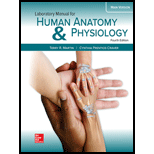
Introduction :
Breathing is controlled from regions of the brainstem respiratory centers, which control both inspiration and expiration. These areas initiate and regulate nerve impulses that travel to various muscles of breathing.
Answer to Problem 1PL
Correct answer :
The correct answer is option (d) Pineal gland.
Explanation of Solution
Explanation/justification for the correct answer :
Option (d) Pineal gland.Pineal gland is a small conical endocrine gland that arises from the roof of the third ventricle of the brain. It produces melatonin and serotonin and may be involved in mood and timing the onset of puberty.So, the correct answer is option (d).
Explanation for incorrect answer :
Option (a) Brainstem. Breathing is controlled at two levels; conscious and unconscious. The autonomic, unconscious cycle of breathing is controlled by brainstem respiratory centers, such as the ventral respiratory group, dorsal respiratory group and pontine respiratory group.So, this is an incorrect option.
Option (b) Pons. Pontine respiratory group is present in pons.Neurons in the pons compose the pneumotaxic center. Input to the pneumotaxic center includes the cerebral cortex are conducted to the dorsal respiratory group and the ventral respiratory group and the respiratory rhythm gets modified. So, this is an incorrect answer.
Option (c) Medulla oblongata.The ventral respiratory group and the dorsal respiratory group which control the autonomic, unconscious cycle of breathing is present in medulla oblongata.So, this is an incorrect answer.
Want to see more full solutions like this?
Chapter 53 Solutions
Laboratory Manual for Human Anatomy & Physiology Main Version
- 18. The bronchial arteries nourish the tracheobronchial tree down to, and including, which of the following? A. Respiratory bronchioles B. Segmental bronchi C. Terminal bronchioles D. Subsegmental bronchiarrow_forwardThe respiratory components of the medulla consist of which of the following? Dorsal respiratory group Apneustic center Ventral respiratory group Pneumotaxic center 1 only 2 only 1 and 3 only 2 and 4 onlyarrow_forwardRespiratory arrest would most likely result from a tumor of the:- a. pons. b. midbrain. c. thalamus. d. cerebellum. e. medulla oblongataarrow_forward
- The conducting zone in the respiratory system has the following function a. Movement of gases only b. Movement and exchange of gases c. Exchange of gases only d. Transport of gases to the tissuesarrow_forwardThe pleura that surrounds the lungs consists of two layers, the ________.a. visceral and parietal pleurae.b. mediastinum and parietal pleurae.c. visceral and mediastinum pleurae.d. none of the abovearrow_forwardThe structures in the passageways of the lung which become paralyzed in the early stages of chronic bronchitis so they cannot sweep out contaminants are the: A. Cilia B. Helper T's C. capillaries D. alveoliarrow_forward
- The lungs do not normally collapse because a. they are attached to the thoracic wall with parietal ligaments. b. they are attached to the thoracic wall with the visceral ligaments. c. the pressure in the intrapleural cavity is lower than the pressure in the intrapulmonary space (lungs). d. the pressure in the intrapleural cavity is greater than the pressure in the intrapulmonary space (lungs).arrow_forwardThe cartilage of the larynx forms the laryngealprominence.a. arytenoidb. cuneiformc. thyroidd. cricoidarrow_forwardThe source of pulmonary surfactant is:- a. the visceral pleura. b. bronchial glands. c. alveolar capillaries. d. squamous alveolar cells. e. great alveolar cellsarrow_forward
- Which of the following statements about choking is true?a. It triggers the cough reflex.b. It occurs when a foreign particle blocks the alveoli.c. Partial blockage of the airway always causes death.d. The cough reflex makes one chokearrow_forwardWhich of the following statements are true of the alveoli and pulmonary capillaries? (Read carefully and select all of the correct statements.) A. Blood coming into the pulmonary capillaries is low in O2 and high in CO2. B. The alveolar walls are one cell in thickness.C. The total alveoli provide a large surface area for gas exchange.D. The pulmonary capillaries are made of simple squamous epithelium. E. Blood leaving the pulmonary capillaries will return to the left atrium of the heart.arrow_forwardDuring acute epiglottitis, the epiglottis swells to several times its normal size. This would interfere directly with: a. internal respiration b. external respiration c. breathing d. gas exchange in the alveoliarrow_forward
 Cardiopulmonary Anatomy & PhysiologyBiologyISBN:9781337794909Author:Des Jardins, Terry.Publisher:Cengage Learning,
Cardiopulmonary Anatomy & PhysiologyBiologyISBN:9781337794909Author:Des Jardins, Terry.Publisher:Cengage Learning, Fundamentals of Sectional Anatomy: An Imaging App...BiologyISBN:9781133960867Author:Denise L. LazoPublisher:Cengage Learning
Fundamentals of Sectional Anatomy: An Imaging App...BiologyISBN:9781133960867Author:Denise L. LazoPublisher:Cengage Learning- Basic Clinical Lab Competencies for Respiratory C...NursingISBN:9781285244662Author:WhitePublisher:Cengage
 Comprehensive Medical Assisting: Administrative a...NursingISBN:9781305964792Author:Wilburta Q. Lindh, Carol D. Tamparo, Barbara M. Dahl, Julie Morris, Cindy CorreaPublisher:Cengage Learning
Comprehensive Medical Assisting: Administrative a...NursingISBN:9781305964792Author:Wilburta Q. Lindh, Carol D. Tamparo, Barbara M. Dahl, Julie Morris, Cindy CorreaPublisher:Cengage Learning





